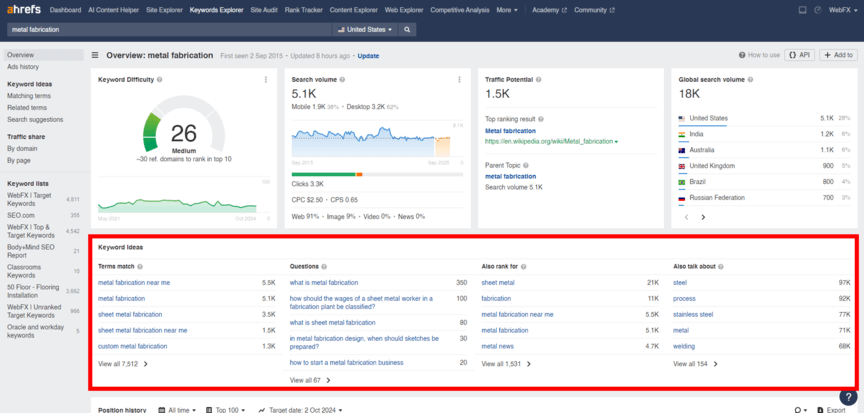O que são palavras-chave de baixo custo? As palavras-chave de baixo potencial são termos de pesquisa fáceis de classificar, geralmente porque têm um alto volume de pesquisa, mas pouca concorrência.
Seja em um contexto de negócios ou não, você provavelmente já ouviu a frase "low-hanging fruit". Ela é usada para se referir a coisas que são fáceis de conseguir - se você estiver colhendo frutas, as frutas nos galhos mais baixos são as mais fáceis de pegar.
O que talvez você não saiba é que o termo também tem um significado específico de marketing.
Para ser mais específico, os profissionais de marketing costumam falar sobre palavras-chave de baixo custo. Isso surge no contexto da otimização de mecanismos de busca (SEO), em que é necessário direcionar palavras-chave específicas para que o conteúdo do seu site seja classificado nos resultados de busca. Mas o que são palavras-chave de baixo potencial e qual é a sua importância?
Nesta página, veremos o seguinte:
- Quais são as palavras-chave mais comuns?
- Por que o SEO low-hanging fruit é importante?
- Seu guia para encontrar palavras-chave de baixo custo
Continue lendo para saber mais!
Quais são as palavras-chave mais comuns?
As palavras-chave de baixo impacto são termos considerados fáceis de classificar nos resultados de pesquisa. Elas representam a combinação ideal de qualidades de palavras-chave - baixa dificuldade e concorrência com uma quantidade razoável de tráfego.
Por que o SEO low-hanging fruit é importante?
Há alguns benefícios significativos em encontrar palavras-chave de baixo custo, inclusive:
- Menos concorrência: As palavras-chave de baixo custo geralmente têm menos empresas competindo por elas, portanto, você tem menos concorrência por classificações.
- Classificações mais altas: Essas palavras-chave são mais fáceis de serem classificadas, o que significa que é mais fácil obter uma classificação elevada (potencialmente até mesmo no primeiro lugar dos resultados de pesquisa).
- Menos tempo e esforço: Como as classificações são mais fáceis com essas palavras-chave, elas exigem muito menos tempo e esforço de sua parte. Isso significa que você tem mais tempo para se dedicar a outras palavras-chave e processos.
- Mais tráfego: Além de trazer classificações mais altas, as palavras-chave de baixo custo também tendem a trazer mais tráfego para o seu site, que é o objetivo principal da segmentação de palavras-chave.
- Mais conversões: Como seu site atrai mais tráfego devido a essas palavras-chave, você poderá gerar mais conversões, o que leva a mais receita.
Como você pode ver, há uma infinidade de benefícios que vêm com a segmentação de palavras-chave de baixo custo, portanto, vale a pena priorizar esses termos ao realizar SEO.
Seu guia para encontrar palavras-chave de baixo custo
Estabelecemos a definição e a importância do SEO low-hanging fruit, mas a questão é: como você encontra os termos certos? A resposta é que você deve seguir um tipo específico de processo de pesquisa de palavras-chave.
É claro que os detalhes desse processo serão inevitavelmente um pouco diferentes, dependendo da ferramenta que você usar. Algumas de suas opções são:
Essas e muitas outras ferramentas existem para ajudá-lo a encontrar as palavras-chave certas, sem mencionar a opção de simplesmente fazer uma pesquisa manual.
Como não vale a pena o esforço de fornecer tutoriais separados para 10 ferramentas diferentes, usaremos apenas o Ahrefs como exemplo nesta página. Você pode modificar o processo conforme necessário para outras ferramentas.
Etapa 1: Insira uma palavra-chave inicial
A primeira coisa que você deve fazer é acessar o Ahrefs, fazer login e ir para a ferramenta Explorador de palavras-chave. Depois de fazer isso, você pode começar pesquisando uma palavra-chave inicial. A ideia é digitar uma palavra-chave que esteja de acordo com o que você deseja segmentar para que o Ahrefs possa gerar palavras-chave relacionadas. Neste exemplo, vamos pesquisar "fabricação de metais".

Etapa 2: Navegue até as palavras-chave relacionadas
Depois de pesquisar sua palavra-chave, você chegará a uma página que mostrará várias métricas sobre esse termo. O que você deve fazer agora é ir até a seção intitulada "Ideias de palavras-chave".

Abaixo de "Terms match" (Termos correspondentes) e "Questions" (Perguntas), você verá uma lista de termos relacionados. Escolha uma dessas categorias e clique no botão "Exibir tudo" na parte inferior. Isso o levará a uma página na qual você poderá visualizar uma longa lista de termos semelhantes ao que você pesquisou, juntamente com várias métricas relacionadas a cada um deles.

Etapa 3: Identifique as palavras-chave mais comuns
É aqui que você pode começar a encontrar palavras-chave de baixo custo. Então, como você descobre quais palavras-chave se qualificam? A resposta é se concentrar principalmente em duas métricas: Dificuldade da palavra-chave (KD) e valor de pesquisa (SV). Se quiser, você também pode analisar o potencial de tráfego (TP).
Usando essas métricas, você deseja encontrar palavras-chave que atinjam um bom equilíbrio entre elas. Ou seja, você quer palavras-chave com um KD baixo e um SV alto (bem como um TP alto, se estiver incluindo essa métrica). Para a maioria das palavras-chave, o KD e o SV serão altos ou baixos. Mas pode haver algumas em que você encontre o equilíbrio ideal.
No exemplo acima, você pode ver que a primeira opção - "fabricação de metais perto de mim" - tem um KD muito baixo de 9 (de 100), enquanto seu SV é o mais alto da lista, com 5,5K. Seu TP também é muito alto, 6,0K. Isso o torna um exemplo perfeito de um produto de baixo custo.
Faz sentido que essa palavra-chave se qualifique, pois a frase "perto de mim" a torna uma palavra-chave inerentemente vinculada ao local. Quando as pessoas pesquisam essa palavra-chave, elas só verão resultados em sua área. Portanto, mesmo que os fabricantes de metais de todo o mundo estejam segmentando esse termo, não estamos competindo com a maioria deles.
Nem toda palavra-chave terá essa configuração ideal. Mas você ainda deve conseguir encontrar algumas que tenham um KD razoavelmente baixo e, ao mesmo tempo, um SV relativamente alto, e essas são as palavras-chave que você deseja segmentar. Basta seguir o processo acima, testando diferentes palavras-chave e analisando todos os termos relacionados, até que você tenha criado uma boa lista de opções.
Pegue mais frutas (de todas as alturas) com o SEO.com
Agora que você sabe como identificar as palavras-chave mais fáceis de serem usadas, é hora de começar a trabalhar.
Mas não se concentre exclusivamente nas palavras mais fáceis. Há muito valor em buscar outras palavras-chave também, palavras-chave que podem ter mais concorrência. E depois há a questão de criar conteúdo em torno delas e classificá-las.
Se isso parece uma perspectiva assustadora, a solução mais simples é fazer uma parceria com uma agência de SEO profissional, como a SEO.com. Com nossos serviços de SEO, você poderá identificar todas as melhores palavras-chave para segmentar, integrá-las ao seu conteúdo e classificar seu site para elas. E, embora cuidemos da carga de trabalho para você, você ainda terá controle total sobre todo o processo.
Interessado em fazer uma parceria conosco? Basta entrar em contato conosco on-line hoje mesmo para começar!

Mais de US$ 3 bilhões
receita gerada para os clientes



Adicione o WebFX à sua caixa de ferramentas de marketing de conteúdo hoje mesmo
Obter proposta de SEOMais de US$ 3 bilhões
receita gerada para os clientes



Adicione o WebFX à sua caixa de ferramentas de marketing de conteúdo hoje mesmo
Obter proposta de SEOO que ler a seguir
- 11 de julho de 2025
- 8 min. de leitura
- 20 de junho de 2025
- 6 min. de leitura
- 28 de maio de 2025
- 7 min. de leitura



